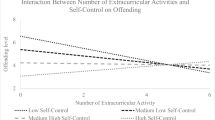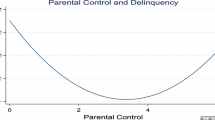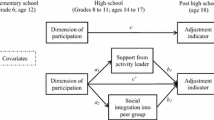Abstract
T. Hirschi’s (1969, Causes of Delinquency. University of California Press, Berkeley, CA) control theory proposes that involvement, as an element of the social bond, should reduce delinquency. But, research studies have found that the effect of involvement is rather weak. This study reformulates Hirschi’s involvement hypothesis by posing involvement as a social setting variable and a differential factor. Certain activities provide a social setting favorable to the development of the social bond and the reduction in delinquent association. The reformulated hypothesis is examined based on a sample of Grade 7–12 students in a Western Canadian city. The results reveal that school- and family-related activities strengthen the social bond and reduce delinquent association and delinquency. In contrast, other conventional activities such as spending time with friends and dating have the opposite effects. In addition, the indirect effect of differential involvement on delinquency through the social bond and delinquent association is stronger than its direct effect. Thus, the undesirable effects of the less-positive activities on delinquency may be buffered or reduced by strengthening the social bond and reducing delinquent association.
Similar content being viewed by others
References
Agnew, R. (1985). Social control theory and delinquency: A longitudinal test. Criminology 23: 47–61.
Agnew, R. (1991a). A longitudinal test of social control theory and delinquency. J. Res. Crime Delinq. 28: 126–156.
Agnew, R. (1991b). The interactive effects of peer variables on delinquency. Criminology 29: 47–72.
Bachman, J. G. (1975). Youth in Transition. Inter-University Consortium for Political and Social Research, Ann Arbor.
Bachman, J. G., and Schulenberg, J. (1993). How part-time work intensity relates to drug use, problem behavior, time use, and satisfaction among high school seniors: Are these consequences or merely correlates? Dev. Psychol. 29: 220–235.
Brame, R., Bushway, S. D., Paternoster, R., and Apel, R. (2004). Assessing the effect of adolescent employment on involvement in criminal activity. J. Contemp. Crim. Jus. 20: 236–256.
Brownfield, D., and Thompson, K. (1991). Attachment to peers and delinquent behaviour. Can. J. Criminol. 33: 45–60.
Buckhalt, J., Halpin, G., Noel, R., and Meadows, M. E. (1992). Relationship of drug use to involvement in school, home, and community activities: Results of a large survey of adolescence. Psychol. Rep. 70:139–146.
Carr, R., Wright, J. D., and Brody, C. J. (1996). Effects of high school work experience a decade later: Evidence from the National Longitudinal Survey. Sociol. Educ. 69: 66–81.
Cassel, R., Chow, P., Demoulin, D. F., and Reiger, R. C. (2000). Extracurricular involvement in high school produces honesty and fair play needed to prevent delinquency and crime. Education 121: 247–251.
Chadwick, B. A., and Top, B. L. (1993). Religiosity and delinquency among LDS adolescents. J. Sci. Stud. Relig. 32: 51–67.
Cohen, A. K. (1955). Delinquent Boys: The Culture of the Gang. Free Press, Glencoe, Illinois.
Collings, P., and Condon, R. G. (1996). Blood on the ice: Status, self-esteem, and ritual injury among Inuit Hockey Players. Human Organ. 55: 253–262.
Corbeil, J.-P. (1995). Sport participation in Canada. Can. Soc. Trends 36: 18–23.
Csikszentmihalyi, M., and Larson, R. (1984). Being Adolescent: Conflict and Growth in the Teenage Years. Basic Books, Inc., New York, NY.
Curry, T. R. (1996). Conservative Protestantism and the perceived wrongfulness of crimes: A research note. Criminology 34: 453–464.
Donnelly, P. (1981). Athletics and juvenile delinquents: A comparative analysis based on a review of literature. Adolescence 16: 415–432.
Duncan, O. D. (1975). Introduction to Structural Equation Models. Academic Press, New York, NY.
Elliott, D. S., Huizinga, D., and Ageton, S. S. (1985). Explaining Delinquency and Drug Use. Sage, Beverly Hills, CA.
Eccles, J. S., Barber, B. L., Stone, M., and Hunt, J. (2003). Extracurricular activities and adolescent development. J. Soc. Issues 59: 865–889.
Evans, T. D., Cullen, F. T., Dunaway, R. G., and Burton, V. S., Jr. (1995). Religion and crime re-examined: The impact of religion, secular controls, and social ecology on adult criminality. Criminology 33: 195–217.
Fallis, R. K., and Opotow, S. (2003). Are students failing school or are schools failing students? Class cutting in high school. J. Soc. Issues 59: 103–119.
Foshee, V., and Bauman, K. E. (1992). Parental and peer characteristics as modifiers of the bond-behavior relationship: An elaboration of control theory. J. Health Soc. Behav. 33: 66–76.
Gardner, L., and Shoemaker, D. J. (1989). Social bonding and delinquency: A comparative analysis. Sociol. Q. 30: 481–500.
Gottfredson, M., and Hirschi, T. (1990). A General Theory of Crime. Stanford University Press, Palo Alto, CA.
Hagborg, W. J. (1991). A study of homework time on a high school sample. Percept. Motor Skill. 73: 103–106.
Hindelang, M. J. (1973). Causes of delinquency: A partial replication and extension. Soc. Probl. 20: 471–487.
Hirschi, T. (1969). Causes of Delinquency. University of California Press, Berkeley, CA.
Hirschi, T., and Gottfredson, M. (1983). Age and the explanation of crime. Am. J. Sociol. 89: 552–584.
Hirschi, T., and Stark, R. (1969). Hellfire and delinquency. Soc. Probl. 17: 202–213.
Hoffmann, J. P., and Xu, J. (2002). School activities, community service, and delinquency. Crime Delinq. 48: 568–591.
Huebner, A. J., and Betts, S. C. (2002). Exploring the utility of social control theory for youth development. Youth Soc. 34: 123–145.
Hughes, R., and Coakley, J. (1991). Positive deviance among athletes: The implications of overconformity to the sport ethic. Sociol. Sport J. 8: 307–325.
Huizinga, D., Esbensen, F.-A., and Weiher, A. W. (1991). Are there multiple paths to delinquency? J. Crim. Law Criminol. 82: 83–118.
Hutchinson, S. L., Baldwin, C. K., and Caldwell, L. L. (2003). Differentiating parent practices related to adolescent behavior in the free time context. J. Leisure Res. 35: 396–422.
Jenkins, P. (1997). School delinquency and the school social bond. J. Res. Crime Delinq. 34: 337–367.
Johnson, R. E. (1987). Mother’s versus father’s role in causing delinquency. Adolescence 22: 305–315.
Kierkus, C. A., and Baer, D. (2002). A social control explanation of the relationship between family structure and delinquent behaviour. Can. J. Criminol. 44: 425–458.
Kornhauser, R. (1978). Social Sources of Delinquency: An Appraisal of Analytic Models. University of Chicago Press, Chicago, IL.
Kouvonen, A., and Kivivuori, J. (2001). Part-time jobs, delinquency and victimization among Finnish adolescents. J. Scand. Stud. Criminol. Crime Prevent. 2: 191–212.
Kremarik, F. (2000). A family affair: Children’s participation in sports. Can. Soc. Trends 58: 20–24.
Krohn, M. D., and Massey, J. L. (1980). Social control and delinquent behavior: An examination of the elements of the social bond. Sociol. Q. 21: 529–543.
Larson, R. (1997). The emergence of solitude as a constructive domain of experience in early adolescence. Child Dev. 68: 80–93.
Larson, R., and Csikszentmihalyi, M. (1978). Experiential correlates of time alone in adolescence. J. Personality 46: 677–693.
Landers, D. M., and Landers, D. M. (1978). Socialization via interscholastic athletics: Its effects on delinquency. Sociol. Educ. 51: 299–303.
Li, C., Pentz, M. A., and Chou, C. (2002). Parental substance use as a modifier of adolescent substance use risk. Addiction 97: 1537–1550.
Liska, A. E., and Reed, M. D. (1985). Ties to conventional institutions and delinquency: Estimating reciprocal effects. Am. Sociol. Rev. 50: 547–560.
Long, C. R., and Averill, J. R. (2003). Solitude: An exploration of benefits of being alone. J. Theory Soc. Behav. 33: 21–44.
Lutz, D. F. (1981). Juvenile delinquency and recreation. Phys. Educ. Recreat. Dance 52: 81–82.
Marsh, H. W. (1993). The effects of participation in sport during the last two years of high school. Sociol. Sport J. 10: 18–43.
Matsueda, R. L. (1982). Testing control theory and differential association: A causal modeling approach. Am. Sociol. Rev. 47: 489–504.
McNeal, R. B., Jr. (1995). Extracurricular activities and high school dropouts. Sociol. Educ. 68: 62–81.
Mitchell, J., Dodder, R. A., and Norris, T. D. (1990). Neutralization and delinquency: A comparison by sex and ethnicity. Adolescence 25: 487–497.
Nagan, D. S., and Farrington, D. P. (1992). The onset and persistence of offending. Criminology 30: 501–523.
Natriello, G., and McDill, E. L. (1986). Performance standards, student effort on homework, and academic achievement. Sociol. Educ. 59: 18–31.
Newberry, A. L., and Duncan, R. D. (2001). Roles of boredom and life goals in juvenile delinquency. J. Appl. Psychol. 31: 527–541.
Osgood, D. W., O’Malley, P. M., Bachman, J. G., and Johnston, L. D. (1989). Time trends and age trends in arrests and self-reported illegal behavior. Criminology 27: 389–417.
Paik, H., and Comstock, G. (1994). The effects of television violence on antisocial behavior: A meta-analysis. Commun. Res. 21: 516–546.
Paternoster, R., and Iovanni, L. (1986). The deterrent effect of perceived severity: A reexamination. Soc. Forces 64: 751–777.
Polk, K. (1984). The new marginal youth. Crime Delinq. 30: 462–480.
Poulsen, L. H., Osler, M., Roberts, C., Due, P., Damsgaard, M. T., and Holstein, B. E. (2002). Exposure to teachers smoking and adolescent smoking behavior: Analysis of cross sectional data from Denmark. Tobacco Contr. 11: 246–251.
Riley, D. (1987). Time and crime: The link between teenage lifestyle and delinquency. J. Quant. Criminol. 3: 339–354.
Robertson, B. J. (1999). Leisure and family: Perspectives of male adolescents who engage in delinquent activity as leisure. J. Leisure Res. 31: 335–358.
Roscoe, B., and Callahan, J. E. (1985). Adolescents’ self-report of violence in families and dating relations. Adolescence 20: 545–553.
Rubin, K. H., Hymel, S., and Mills, R. S. L. (1989). Sociability and social withdrawal in childhood: Stability and outcomes. J. Personality 57: 237–255.
Samet, N., and Kelly, E. W., Jr. (1987). The relationship of steady dating to self-esteem and sex role identity. Adolescence 22: 231–245.
Segrave, J. O., and Hastad, D. N. (1984). Future directions in sport and juvenile delinquency research. Quest 36: 37–47.
Simons, R. L., Stewart, E., Gordon, L. C., Conger, R. D., and Elder G. H., Jr. (2002). A test of life-course explanations for stability and change in antisocial behavior from adolescence to young adulthood. Criminology 40: 401–434.
Statistics Canada (1994). Working teens. Can. Soc. Trends 35: 18–22.
Steffensmeier, D. J., Allan, E. A., Harer, M. D., and Streifel, C. (1989). Age and the distribution of crime. Am. J. Sociol. 94: 803–831.
Steinberg, L., and Dornbusch, S. M. (1991). Negative correlates of part-time employment during adolescence: Replication and elaboration. Dev. Psychol. 27: 304–313.
Steinberg, L., Fegley, S., and Dornbusch, S. M. (1993). Negative impact of part-time work on adolescent adjustment: Evidence from a longitudinal study. Dev. Psychol. 29: 171–180.
Sutherland, E. H., and Cressey, D. R. (1974). Criminology. J. B. Lippincott, Philadelphia, PA.
Tanner, J., and Krahn, H. (1991). Part-time work and deviance among high school seniors. Can. J. Sociol. 16: 281–302.
Thornberry, T. (1987). Toward an interactional theory of delinquency. Criminology 25: 863–891.
Thornberry, T. P., Lizotte, A. J., Krohn, M. D., Farnworth, M., and Jang, S. J. (1991). Testing interactional theory: An examination of reciprocal causal relationships among family, school, and delinquency. J. Crime Law Criminol. 82: 3–35.
Tucker, L. A. (1985). Television’s role regarding alcohol use among teenagers. Adolescence 20: 593–598.
Vitaro, F., Wanner, B., Brendgen, M., Gosselin, C., and Gendreau, P. L. (2004). Differential contribution of parents and friends to smoking trajectories during adolescence. Addictive Behav. 29: 831–835.
Wiatrowski, M. D., Griswold, D. B., and Roberts, M. K. (1981). Social control theory and delinquency. Am. Sociol. Rev. 46: 525–541.
Wright, J. P., Cullen, F. T., and Williams, N. (1997). Working while in school and delinquent involvement: Implications for social policy. Crime Delinq. 43: 203–221.
Yin, Z., Katims, D. S., and Zapata, J. T. (1999). Participation in leisure activities and involvement in delinquency by Mexican American adolescents. Hispanic J. Behav. Sci. 21: 170–185.
Young, K. (1993). Violence, risk, and liability in male sports culture. Sociol. Sport J. 10: 373–396.
Author information
Authors and Affiliations
Corresponding author
Additional information
Siu Kwong Wong is an Associate Professor of Sociology at Brandon University. He received his Ph.D. in Sociology from Washington State University. His major research interests are in the study of delinquency and social disorganization.
Rights and permissions
About this article
Cite this article
Wong, S.K. The Effects of Adolescent Activities on Delinquency: A Differential Involvement Approach. J Youth Adolescence 34, 321–333 (2005). https://doi.org/10.1007/s10964-005-5755-4
Received:
Revised:
Accepted:
Issue Date:
DOI: https://doi.org/10.1007/s10964-005-5755-4




